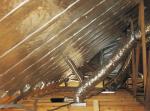Search engine visitors - click here to access entire "$ensible Home" web site
Click here to see a descriptive illustration of how to install attic foil and attic vents.
Dear Jim: I have plenty of fiberglass insulation on the attic floor, but it still seems as though the ceiling is warm on sunny days and the air conditioner runs like crazy. What can I do to keep it cooler? - Steve P.

A: If you put you hand against the ceiling, you would be surprised how warm it actually is. This will increase your cooling electric bills. This warmth also radiates to your body making you feel uncomfortably warm even at a reasonably cool room temperature. When this happens people tend to set the thermostat even lower which further increase the electric bills. Every degree the air conditioner thermostat is lowered can increase your electricity bills by up to three percent.
What you are experiencing is radiant heat transfer from the hot roof to the ceiling below. A dark roof can reach 150 degrees in the afternoon sun. Radiant heat transfer is unique in that it increases at a very fast rate as the temperature increases. For example, a roof at 150 degrees can radiate more than 10 times as much heat to the ceiling below as a roof at 120 degrees.
Standard fiberglass insulation is effective for blocking conductive heat transfer, such as the heat from inside your house to the cold attic during the winter. It is not very effective for blocking the radiant heat from a hot roof. Radiant heat from the roof penetrates through the insulation to the ceiling below. Even the insulation itself gets warm and can actually hold the heat in the ceiling once it gets warm.
The best method to block most of the heat is by installing reflective foil underneath the roof and installing adequate attic ventilation. The foil blocks the direct path for the radiant heat to the ceiling below. Astronauts' space suits use multiple layers of foil to block heat flow. The attic ventilation will cool the roof and carry the excess heat away by natural air flow (hot air is less dense and rises).
I installed attic foil and more attic ventilation in my own home. The temperature in the second-floor bedrooms was immediately 10 degrees cooler in the afternoon and early evening. The attic air exhausting through the new roof vents was so hot, you could not hold your hand in it for very long without discomfort.
Attic foil is commonly referred to as reflective foil because it looks reflective similar to any aluminum foil. It actually works not by reflecting the heat back up to the roof, but by it low-emissivity (similar to low-e windows) properties on its bottom surface. The foil gets hot, but its shiny low-e surface does not easily radiate the heat down. This is why room radiators for heating are a dull dark color instead of shiny so they radiate heat more effectively.
You can find attic foil in long rolls which are about four feet wide at many building supply outlets. It is similar to regular kitchen aluminum foil, except it is reinforced with kraft paper or a nylon mesh or grid so the staples don't pull through. The least expensive type is kraft paper with foil on only one side. Although this may sound strange, because the low-e properties are most important, the shiny side should face down.
Staple the foil up under the roof rafters. The neatness of the job is not critical. It is only important that every part of the roof surface is blocked from the floor below. Leave a small gap above the insulation near the floor and at the ridge so the attic and roof are well ventilated. This is particularly effective with a continuous roof ridge vent.
Another option is to have the underside of the roof sprayed with a special Lo/Mit reflective, low-e coating. It has the appearance of aluminum paint. This has a similar effect to the foil to reduce the radiant heat from the underside of the roof. If you are replacing the roof sheathing or building a new home, sheathing is available with a foil backing already applied so additional foil is not needed.
Installing a ridge vent in the attic is most effective. The hot air naturally rises to the peak of the roof where it is exhausted. Ridge vent is not difficult to install. It is available in long rolls or as rigid sections which are nailed over a slot along the roof ridge beam. It is also important to install adequate inlet vent area along the soffit under the roof overhang.
Instant Download Update Bulletin No. 411 - buyer's guide of 20 manufacturers of do-it-yourself attic foil, heat-blocking attic paint, ridge vent kits, prices and installation instructions for a radiant barrier, installation instructions for a roll-out shingle over a ridge vent, safety tips for installing an attic radiant barrier system, sizing chart for area of foil needed.
Dear Jim: Even though it wastes water, I rinse my dishes first because my dishwasher does not clean as well as it used to. What are the possible causes of this problem and how can I fix it? - W. L.
A: Two likely causes of poor cleaning are clogged spray holes or a cracked spray arm. Over time, small particles can build up and totally clog some of the holes. Inspect the spray holes and clean them out with a safety pin.
A cracked spray arm lets water leak out the side of the arm instead of spraying on the dishes. First, try repairing it with high temperature epoxy glue. If it leaks again, the arm will have to be replaced.